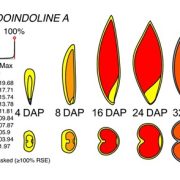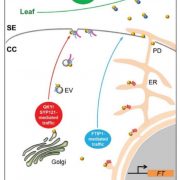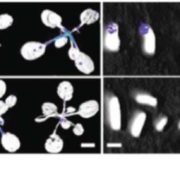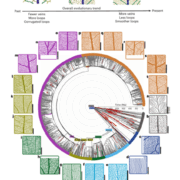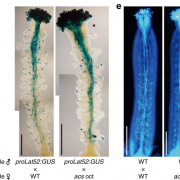Review: Cycads, chemicals, and coevolution
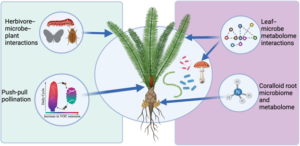 Cycads are an ancient lineage of gymnosperms with fascinating ecological interactions. In a recent review, Salzman et al. examine the various adaptations of cycads, from attracting pollinators to repelling parasites, focusing on the roles of their wide array of specialized metabolites. A somewhat unique trait in gymnosperms, most cycads have obligate insect pollination. To attract pollinators, cycads release a wide array of volatile organic compounds (VOCs) in their cones. As dioecious plants, they utilize daily fluctuations of VOCs to attract pollinators to their male cones to gather pollen, then repel them to encourage them towards female cones. Certain genera of cycads are thermogenic, with the ability to generate heat in their cones to queue insect pollinators. Aside from pollinator interactions, cycads also produce a myriad of phytotoxins in their foliage, which has driven tight coevolutionary relationships with specialized insects that have adapted to withstand these chemical defenses. Their use of secondary metabolites extends to below ground tissue where they secrete metabolites to attract nitrogen-fixing mutualists and boost their metabolic activity. Because they retain many ancient traits not found in most gymnosperms, cycads present a valuable opportunity to help bridge the gap between living and early seed plants, offering key insights into the evolutionary history of plant-animal interactions. (Summary by Xavier Ozowara [email protected]). New Phytologist https://doi.org/10.1111/nph.70109
Cycads are an ancient lineage of gymnosperms with fascinating ecological interactions. In a recent review, Salzman et al. examine the various adaptations of cycads, from attracting pollinators to repelling parasites, focusing on the roles of their wide array of specialized metabolites. A somewhat unique trait in gymnosperms, most cycads have obligate insect pollination. To attract pollinators, cycads release a wide array of volatile organic compounds (VOCs) in their cones. As dioecious plants, they utilize daily fluctuations of VOCs to attract pollinators to their male cones to gather pollen, then repel them to encourage them towards female cones. Certain genera of cycads are thermogenic, with the ability to generate heat in their cones to queue insect pollinators. Aside from pollinator interactions, cycads also produce a myriad of phytotoxins in their foliage, which has driven tight coevolutionary relationships with specialized insects that have adapted to withstand these chemical defenses. Their use of secondary metabolites extends to below ground tissue where they secrete metabolites to attract nitrogen-fixing mutualists and boost their metabolic activity. Because they retain many ancient traits not found in most gymnosperms, cycads present a valuable opportunity to help bridge the gap between living and early seed plants, offering key insights into the evolutionary history of plant-animal interactions. (Summary by Xavier Ozowara [email protected]). New Phytologist https://doi.org/10.1111/nph.70109


